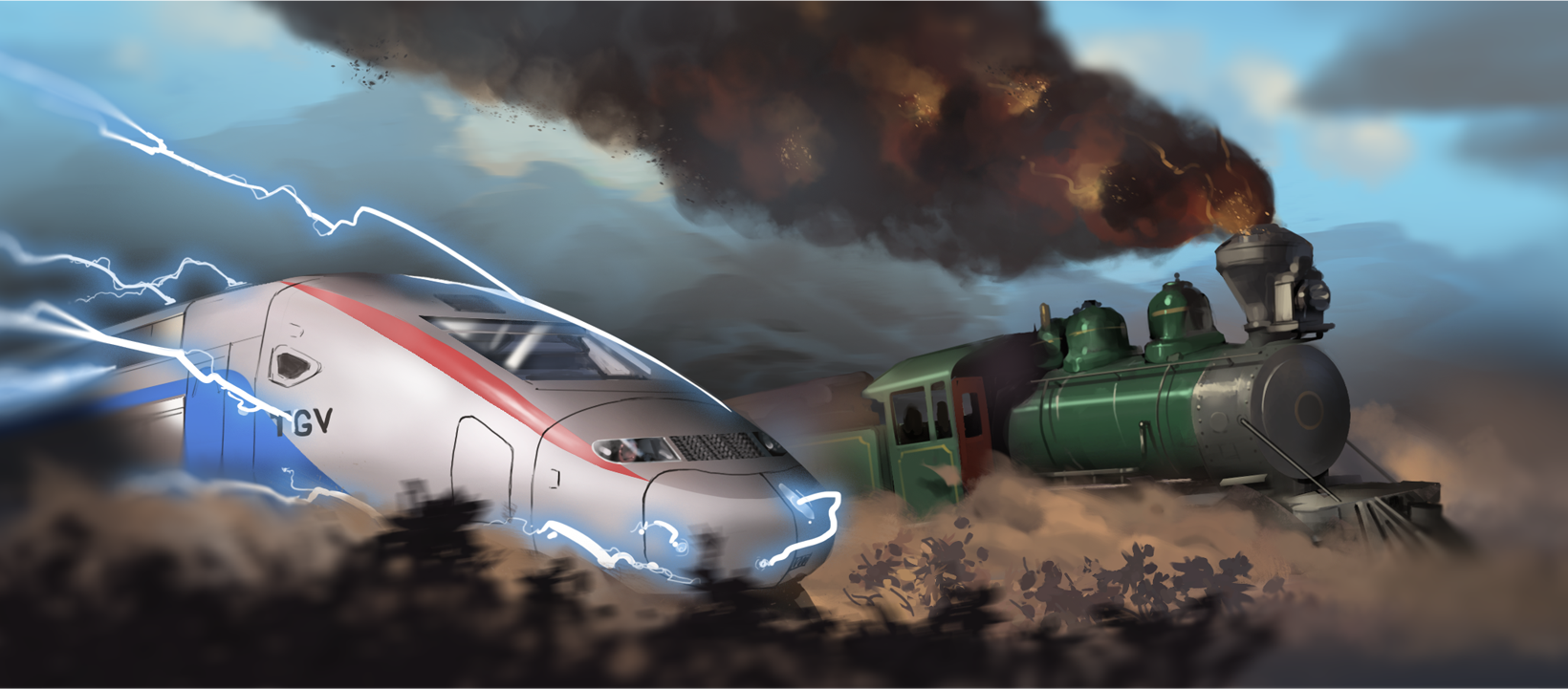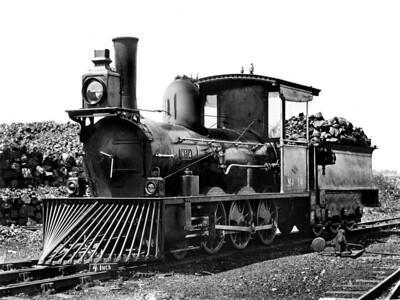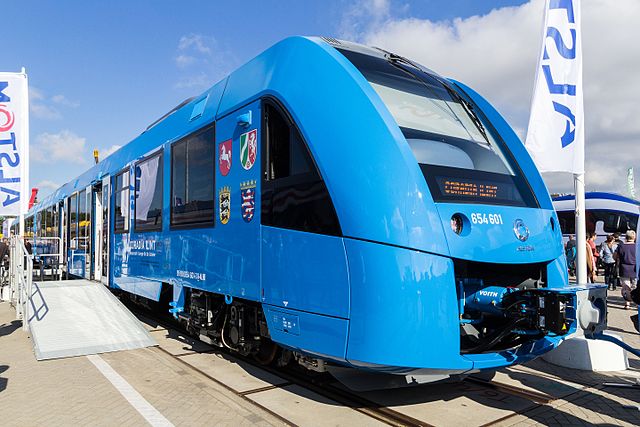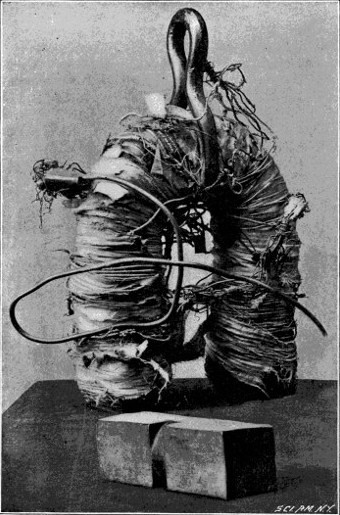
On many levels people (scientists, experts, powerbrokers of many sorts) consider that economy is nothing more than “transformed energy”. One could agree indeed that any economic output has to be fuelled at some point by one kind of energy – whether this energy is carbon based, renewable or dispensed from a brain burning calories to function. However, perhaps, this adage reaches its full potential when put into perspective with what trains brought to the human civilization and what they allowed to accomplish in terms of economic development, communication, convenience etc. while simply burning coal and being propelled on tracks from this simple combustion. Writing, the wheel, the printing press, the lightbulb, nuclear fission, the internet… The train deserves its place in the hall of fame of the inventions that shaped the world into what it is today.
But what moves these trains? What put them into motion from behemoth like masses of metal into fast moving (yet comfortable!) objects of transportation? At this very moment where energy is perhaps the most discussed topic on the planet, in the forthcoming of potential shortages, very likely exponential speculations and inevitable rising demands facing unsecured supplies, let’s take a moment to go back in time, to take a closer look at what forms of energy have been fuelling trains all over the world, from this first and moving entrance in the town of Darlington in the year of our lord 1825 to today’s web of metropolitans and mysterious “sky trains”…

In the beginning was the elbow grease
We could realistically skip the first train energy ever used as it probably was not a “true” form of energy but just unlucky labourers pushing up and down these iconic and old west types of hand-lever draisine handcar. The reason why we mention them though is not to only to provide an exhaustive list of various energy used to power up trains (as one would argue and as we said it already, sweating is not a reliable source of energy) but because it made possible, partially at least, the next and real source of energy: in truth, these handcars were mostly used to carry coal out of mines – the very coal which would then be used to produce steam and move trains with a bit more pace than sweat allowed.

Before coal phase-out there was… coal!
It’s not a secret, the first trains were fuelled by the most widely used source of energy which was the quintessential fossil fuel that is coal. While it has become the enemy of modern civilizations, coal has been an essential asset in human development by providing heat, energy, enriching metal and alloys and taking many societies from the rural and agricultural world they were in into urban and industrial megacities. While there was undeniable collateral damages in the process (and as a matter of fact, still are), just because we don’t want to use coal anymore we shouldn’t ban it from history. Facts are stubborn! And coal was the dedicated train propellant from the very first piston engine invented by Scotsman James Watt [https://en.wikipedia.org/wiki/James_Watt] until roughly the 1930’s. It is worth to note that the abandon of coal for another source of energy didn’t happen overnight and took a good 30 years. Also important to know: coal trains are trains assigned to carrying coal (typically in the American northwest) and can often reach 2 or even 3 kilometers long (with sometimes more than 150 wagons!) – the first trains powered by coal were actually set in motion by steam, produced by the combustion of coal.
The electrickery of energy you can’t see…
You can’t really see it unless you’re doing something with it you shouldn’t be doing. You can’t really smell it, hear it, touch it (and neither should you! by all means), store it, taste it… You can’t do much with it as it seems, but at the same you can’t do anything without it. This isn’t a treacherous enigma, it is electricity. And electricity can be considered the second energy in the history of trains and their power source. Although you don’t harvest or mine electricity like coal and you do need another type of energy to produce it (as for example… coal!), electricity produced one way or the other, was widely used, and still is, to propel trains. We owe the miracle of electrical trains (and not the kind you can see drive around your miniature landscape in your garage) to another Scotsman kown as Robert Davidson which he came up with in 1837. While it could be surprising to those who have a hard time believing that so early in trains’ history our ancestors were already doing it according to nowadays energy standards (except for the coal burning plants that produced that electricity), just think of every western capital tramway or “tram” network, which fed electricity to their many engines from all these overhead lines and wires. And it also explains why back in the days, everybody wore hats: so much static in the city air had a tendency to puff up everyone’s hair and made them look like moving disco balls – this last statement might lack scientific and historic evidence.
Before it became a perfume, Diesel used to smell real bad and also move trains…
Next on the list of the undesirable, right below coal and even above raw oil, is diesel. Rarely the son of a known mischievous father will surpass his elder as diesel has with oil – from which it is derived. Smelly, greasy, polluting, treacherous – and the list goes on, diesel was nevertheless the replacement of choice which stored all steam engines in the museum. We know, our ancestors had a tendency to sacrifice almost everything on the altar of efficiency, and whether pollution or war were a byproduct of it didn’t seem to stop them. And efficiency it was! Diesel, from the name of a particularly crafty German engineer (Rudolf by his first name) would allow a much higher output for trains and the distance they could cover without having to refuel. Cheaper, faster, longer, and it was definitely enough for the diesel trains to be widely adopted. Although, an no offense to Herr Diesel, the conception of the diesel engine is largely based on an initial “petroleum engine” from an English inventor named William Priestman. Yet again, it appears that the United Kingdom participation to science and train engineering is infinite. If the replacement of steam trains by diesel engines in the US (where it happened before spreading to the rest of the world) really began in 1930 and until the 1960’s, the world’s first diesel train to be used commercially ran in Switzerland in 1912.

Two centuries of smoke & back to the cleanliness of sweat
Undeniably, a lot of coal was burned, a lot of diesel pumped, and an incommensurable amount of smoke produced since 1825. Finally it was in 2018 that the first clean energy train was introduced: back to where it all began when coal covered bearded miners were moving handcars in full harmony with nature. It is this time in Germany, a country fascinated by engineering and dedicated to the preservation of the environment that the first hydrogen train was introduced as a commercial passenger train. The Alstom Coradia Lint can be taken in Lower Saxony, a German “Länder” previously known for its hearty food, its farming, rural and peaceful living, and now its “Hydrail”, the first train to be responsible for zero carbon dioxide emission. Niedersachsen, a land of traditions which has an obvious knack for progress.
Since the 1960’s the world saw the introduction of the “High-speed” rail system (with a world record for the French TGV set at 547km/h!) it is important to mention that nowadays, most countries rely on both diesel and electric trains. And while electric trains emit by far the lowest amount of carbon dioxide among all public means of transportation (80 times less by passenger compared to a non electric car!) we cannot exclude the way this electricity was produced in the equation as if some methods of production are clean(er), some still count coal among them and one can’t stop considering that running electric trains on electricity produced by coal factories is a conundrum crying out loud for a logical alternative.

And last but not least… Magic! Or something actually called “neodymium”
Although they never shied away from roaring coal factories to supply their massive electricity production needs, the Chinese have also demonstrated a true gift for cutting edge technology which can also help reduce their impact on the environment. This real talent for science plus the fact that they sit on the worlds largest reserve of rare earths has allowed them to create the “Red Rail”, a very unique type of magnetic “sky train”. Originally, engineers realized that having trains up in the air connected to a magnetic rail system had two major advantages: first it limited the property and real estate needs that usual tracks require (and which in megapolis is always an issue) and also, because the force of friction of wheels on tracks basically disappeared (also due to the magnetic rail system), less energy was needed to propel the trains. Until now, these giant electromagnets would require quite a lot of energy to operate – which as in clean electrical trains powered by smokey coal factories seems paradoxical. And then, the Nd element, with atomic number 60, got on stage and stole the show: this element called neodymium allows for the existence of just as gigantic magnets that are known as “permanent magnets”. These do not need any energy and therefore, the train can be moved with far less energy than it normally would require, thus solving this conflictual absurdity once and for all.
Now, without the coal used to produce this energy in the first place, it looks like we’d have a real and winning system. And, given how exponentially faster progress happens, we probably will not have to wait another 200 years to see this happen, like the time it took to go from steam to hydrogen engines. At least, one would hope.